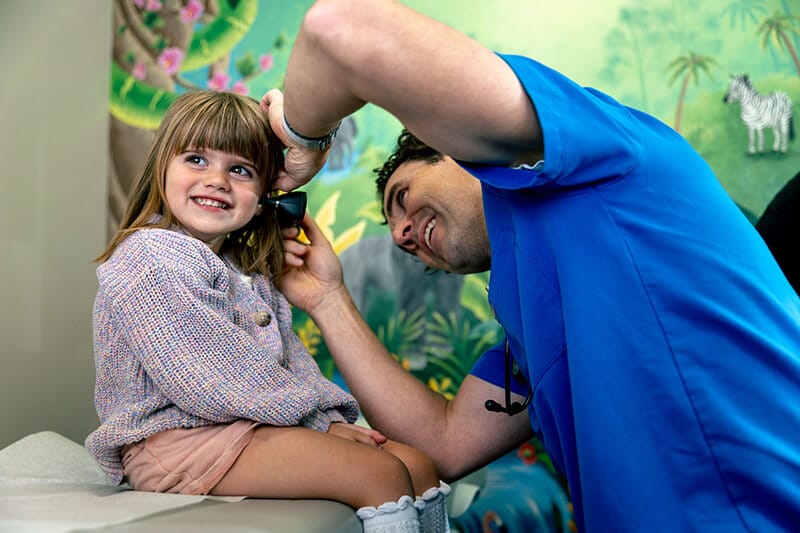Let’s just get this right out in the open: There is no secret baby language dictionary, no gadget you can buy, or an interpreter you can hire that can translate baby language into anything you would recognize. Anyone who claims they can is likely to sell you something.
However, that isn’t to suggest that your baby’s cries, sounds, and attempts at language are without meaning. Babies send messages through coos and cries—and interpreting these signals early can build healthy parent-baby communication habits.
What it Means When Your Baby Cries
Crying is the first way your baby’s language sounds can communicate with you, and, for a little while, it’s their main way. While you might associate crying with distress, that isn’t necessarily the case for your baby. Because crying is your baby’s first and main way of communicating with the world, they’re likely to use it liberally for just about every emotion they want to share.
While there’s no newborn cry language secret to decoding the meaning behind a specific cry, there are a few usual suspects to pull in for questioning. If your baby is crying and you’re not sure why, here are pediatric tips for understanding infant sounds:
Hungry Cry
This one is pretty straightforward. Babies are doing a lot of growing and learning, and that’s newborn language for hunger at work. Offering a breast or a bottle is a good place to start. If breastfeeding is frustrating for you or your baby, schedule an appointment with an in-house lactation consultant. Be careful not to overfeed by looking for other signs of hunger, like rooting or other attempts to find a nipple.
Tired Cry
Food can keep the baby cry language train chugging along for a while, but eventually, they need to pull into the station. Your baby isn’t mature enough to recognize tiredness and soothe themselves to sleep. But they know something is wrong, and they could use some help in the form of rocking, singing, gentle massage, etc. Tired babies also tend to signal their feelings by pulling at their ears and making jerky motions with their limbs.
Cries of Discomfort
Little bodies are sensitive and prone to discomfort. Check newborns for tight clothing, soiled diapers, and overheating. Too direct sunlight, too many layers of clothing, or a stiff breeze might be enough to frustrate your baby.
Crying Due to Over or Under Stimulation
Babies crave and need interaction. They learn best when interacting with others and will let you know if they need attention. By contrast, too much stimulation can be just as much a problem. If your baby’s crying and there’s a lot going on, they might just need a scene change. Step outside or into a quiet room and see if a calmer pace makes a difference.
Crying Due to Illness
No one likes to think about their baby being sick, but it’s bound to happen eventually. Tummy pain, ear pain, and diaper rash are the three most common baby “illnesses,” and fortunately, each has its unique signals:
- Colic is often accompanied by a tight tummy, burping, a flushed face, or neh cry, meaning baby pulling their legs up close to their bellies when crying.
- Earaches can cause babies to pull at their ears, move their heads side-to-side, discharge liquid from the ear, and/or develop a fever.
- Diaper rash is easier to spot by its red, inflamed skin. However, some babies may have red skin frequently without complaining of diaper rash. Look for other signs, such as sores, bumps, crying as soon as a diaper is wet, crying during diaper changes, and fever.
Coos and Other Sounds Your Baby Makes and What They Mean
While it might feel like the crying phase will never stop, it will become less frequent as you and your baby learn each other’s signals and baby incorporates new baby language sounds. Hearing your baby experiment with different sounds and vocalizations is an exciting milestone, but it also means you’ll have new questions.
Here’s a breakdown of familiar baby sounds and why babies make them:
Cooing
- Some of your baby’s first non-crying sounds.
- Baby makes sounds like “oo,” “aa,” or simple consonant/vowel combinations like “goo.”
- Coos are vocal practice and help babies develop motor control over their vocal cords.
- It’s cute and funny to us and babies.
Bubbles and Raspberries
- Pressing the lips together and blowing air through or sticking the tongue between the lips to blow bubbles.
- Baby is experimenting with new ways to make sounds.
- May also be accompanied by a shift in tone, up or down. This is baby mimicking the kinds of sounds they hear from you.
Babbling
- Babbling is stereotypical “baby talk” when baby starts using repeating, intentional sounds to say things like “baba” or “gaga.”
- Even non-human babies babble to their parents. Babbling probably predates actual language as a way for babies to get the attention of their caregivers.
- Nonverbal babies also babble when learning sign language. In fact, they follow all the same communication milestones, along the same timetable, suggesting that babbling and other early vocalizations are rooted even deeper than the language center.
Laughter
- Laughter can begin as early as 3 months and is the sweetest sound a parent can hear.
- Babies often laugh in response to games and especially enjoy socially interactive games with eye contact, like peekaboo.
- Studies have shown that babies laugh less often and less intensely when alone than when they’re with company, even in response to the same stimuli.
- Laughter isn’t just a response to something funny, it’s an attempt to share their experience and their joy with you. Babies will even look to you before they laugh to make sure you’re there to appreciate it.
Breathing Sounds
- Babies breathe at a different rate and in different ways than adults. A normal respiration rate for your baby is between 40 and 60 breaths per minute, compared to between 12 and 20 for adults.
- Babies sometimes breathe very rapidly for several breaths, followed by a period of no breathing, which can last up to 10 seconds. This is known as Periodic Breathing and is perfectly normal for your baby.
- If breathing pauses for more than a handful of seconds or if your baby exhibits any other signs of respiratory distress (flaring nostrils, pulling in their chest, blue coloring), seek medical intervention as quickly as possible.
The good news is that you likely already know what your baby is telling you in newborn language. You’re standing on the shoulders of generations of human caregivers who came before. No matter what sound your baby is making, your attention, comfort, and love are always a safe response.
Struggling with breastfeeding?
Overcome common nursing challenges and make feeding time rewarding for you and your baby by meeting with one of our friendly, experienced, IBCLC-certified lactation consultants.
Reminder: Most health insurance companies require adding your new child within 30 days of birth. Make a note to add your baby to your policy within this window to ensure all their visits are covered.







